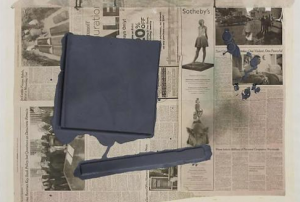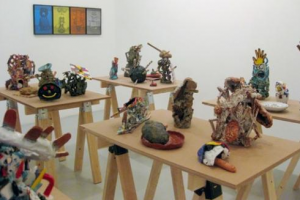
If it weren’t for the schooner by the doorway at Paul Sietsema’s first New York gallery solo, I’d have missed the boat. Not-quite-right details reveal that what looks like an aged old photograph of a sailboat is in fact a meticulous drawing that demonstrates in a flash how painterly skill adds value and interest to an artwork. In this otherwise aesthetically restrained but intellectually stimulating show, Sietsema allows trace evidence of his hand in pieces that look digitally produced or printed, questioning his own role as a craftsman in the digital age and floating an inconclusive but engaging argument that artistic survival means cleverly thwarting expectations.
In the past, Sietsema has exhibited films of sculptural objects; the drawings here allow us the intimacy to appreciate his handiwork. Two untitled pieces resembling expressive abstractions in black ink also include depictions of bottles of Krylon ‘Short Cuts’ paint, humorously highlighting how Sietsema doesn’t take shortcuts in his labor intensive, cerebral, and non-emotive project. At the bottom of one, the phrase “broken down and experimental…broken down beauty,” bespeaks the pleasure of piecing together Sietsema’s deconstructions.
Two pieces titled, ‘Painter’s Mussel’ refer to shells used to hold paint but show Sietsema flexing his intellectual muscle in complicated pictures of disassembled framed photographs drawn to resemble photographic negatives which appear to have been printed. From the aged photograph of the boat and images that pit old technology (the brush) with new, to two pieces replicating the dated medium of newspaper pages (including an article on Obama reversing a Bush policy) Sietsema suggests that with passage of time ascendency fades – the smart artist adapts by working outside of traditional expectations.
Condensed version of this review published in Time Out New York, issue 815, June 2-8, 2011.


